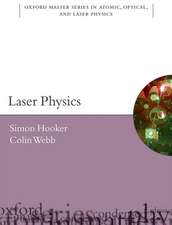How the Ray Gun Got Its Zap: Odd Excursions into Optics
Autor Stephen R. Wilken Limba Engleză Hardback – 28 noi 2013
Preț: 318.16 lei
Preț vechi: 345.82 lei
-8% Nou
Puncte Express: 477
Preț estimativ în valută:
60.88€ • 63.69$ • 50.57£
60.88€ • 63.69$ • 50.57£
Carte tipărită la comandă
Livrare economică 24-29 martie
Preluare comenzi: 021 569.72.76
Specificații
ISBN-13: 9780199948017
ISBN-10: 0199948011
Pagini: 272
Ilustrații: 5 b/w halftones, 2 tables
Dimensiuni: 242 x 163 x 23 mm
Greutate: 0.5 kg
Editura: Oxford University Press
Colecția OUP USA
Locul publicării:New York, United States
ISBN-10: 0199948011
Pagini: 272
Ilustrații: 5 b/w halftones, 2 tables
Dimensiuni: 242 x 163 x 23 mm
Greutate: 0.5 kg
Editura: Oxford University Press
Colecția OUP USA
Locul publicării:New York, United States
Recenzii
Wilk covers his subject with all the expertise and poise of a man thoroughly at one with his subject matter ... Wilk offers us captivating insights into the way we perceive the world
You will be rewarded with both plenty of optics-based entertainment and some excellent knowledge, worthy of Stephen Fry and QI
You will be rewarded with both plenty of optics-based entertainment and some excellent knowledge, worthy of Stephen Fry and QI
Notă biografică
Stephen Wilk is a contributing editor for the Optical Society of America and the author of Medusa: Solving the Mystery of the Gorgon (OUP; 2000). He holds a Ph.D. in Physics and has worked on Laser Propulsion and High Energy Lasers at Textron and MIT's Lincoln Labs, and has designed and built optical apparatus at Optikos Corporation, Cognex, and AOtec. He was previously a visiting professor at Tufts and a visiting scientist at MIT.












